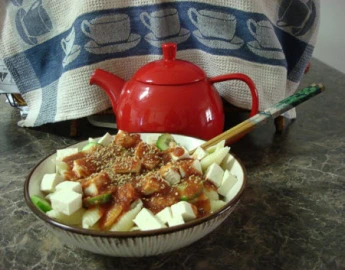This is one of my favourite tea recipes, and it’s especially nice as a warm-weather lunch or light dinner, or as part of dinner. The recipe was inspired by a dish served at a bistro in a small New Jersey town. I convinced the chef/owner to give me his list of ingredients, and from there I tweaked it around. One key component that I added was tea.
As I tried various teas to see which one worked best, I was surprised to find three very different teas that each complemented the dish in its own way. My first test was with a slightly smoky Georgia tea, because I like a cup of smoky tea with spicy foods. Yummy! When I fixed the dish with rice noodles I tried genmaicha, a user-friendly green tea mixed with toasted rice kernels. Another hit! Then came the day when I really wanted this dish but didn’t feel like steeping up another pot of tea, so in my laziness I used leftover oolong tea. Bingo once again!
My first test was with a slightly smoky Georgia tea, because I like a cup of smoky tea with spicy foods. Yummy! When I fixed the dish with rice noodles I tried genmaicha, a user-friendly green tea mixed with toasted rice kernels. Another hit! Then came the day when I really wanted this dish but didn’t feel like steeping up another pot of tea, so in my laziness I used leftover oolong tea. Bingo once again!
My favourite tea for this is oolong, but choose whichever you prefer. For best results use strong tea made with twice as much leaf as usual and steeped for the regular time. If you’re using oolong, make sure it’s not a floral variety (believe me, it’s yucky). A peachy/nutty generic “Formosa oolong” works best.
Now about the other ingredients … You can use almost any kind of noodles or pasta you like; I’ve used wheat, whole wheat, rice, buckwheat – even ramen noodles. Adjust the amount of garlic and cayenne to your own taste. Rice vinegar is available at most supermarkets. The only really exotic ingredient is gomasio, a mixture of salt and sesame seeds sold in natural food stores. If you can’t find it, substitute plain sesame seeds.
The recipe is easily doubled, tripled, or more to serve a crowd, and it’s tea-rrific for picnics or buffets.
Hot and sour sesame noodles
About 4 servings
3/4 pound (12 ounces) noodles, linguine, or pasta
1 teaspoon light oil (peanut, sunflower …)
1/4 cup tomato paste
1/4 cup rice vinegar
1/3 cup strong tea, cooled
2 Tablespoons maple syrup, agave, honey, or other syrupy sweetener
1 Tablespoon tamari or Kikkoman® soy sauce
1 teaspoon garlic powder
1/2 teaspoon crushed cayenne pepper flakes
1 teaspoon toasted sesame oil
Gomasio or sesame seeds
Suggested toppings: cubed tofu, shredded lettuce, shredded carrots, bean sprouts, sliced cucumber, sliced celery, slivered canned water chestnuts, sliced snow peas, slivered scallions, cooked and cooled broccoli florets
Prepare the noodles to al dente tenderness. Rinse with cold water, drain well, and place in a large bowl. Toss the cooked pasta with the light oil; set aside. Mix the tomato paste and vinegar together in a small bowl. Add the remaining ingredients, blending well. Divide pasta into four dishes, top as desired, then spoon on the dressing. Sprinkle each dish lightly with gomasio. Enjoy!
Follow TeaGuide on Twitter @TeaGuide1



